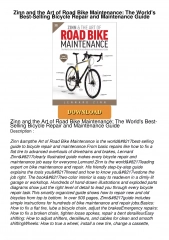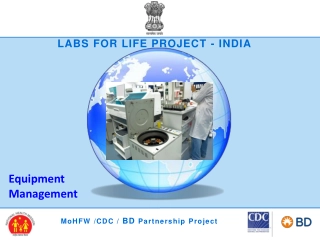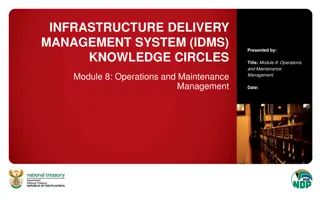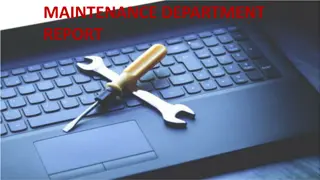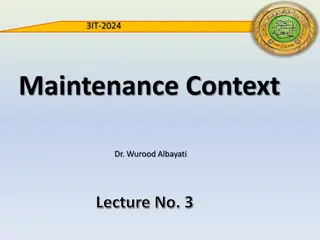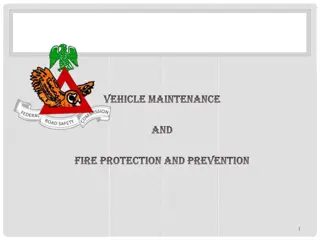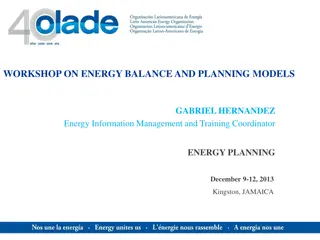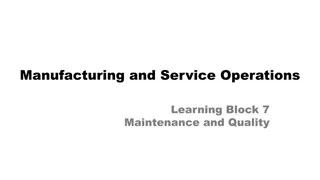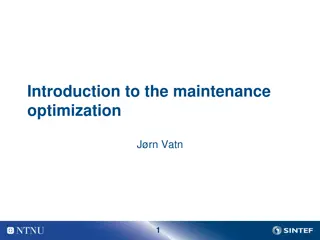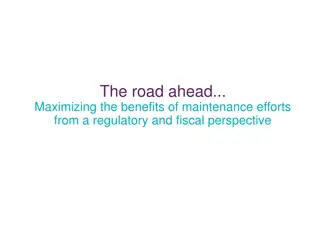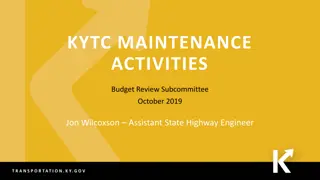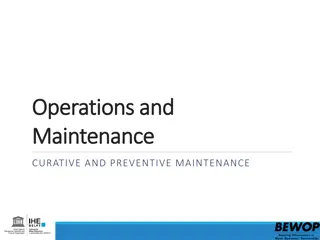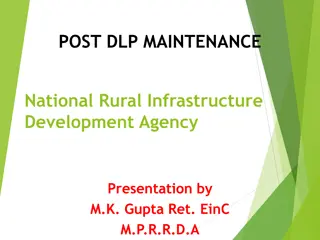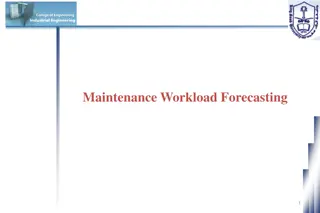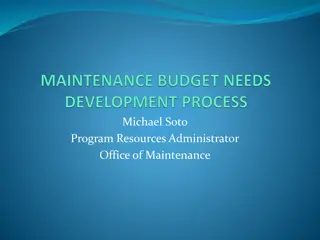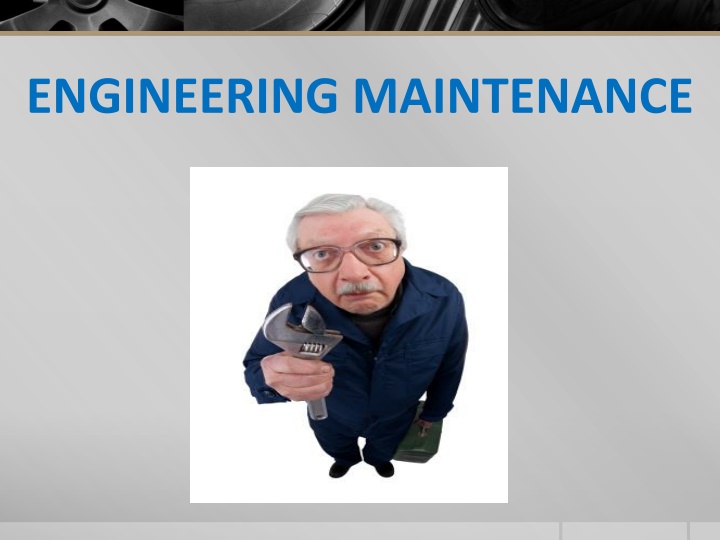
Engineering Maintenance
Explore the various types of maintenance procedures and techniques associated with engineering plant, equipment, and systems. Learn about the significance of maintenance for safety, legal compliance, equipment reliability, and overall operational efficiency.
Download Presentation

Please find below an Image/Link to download the presentation.
The content on the website is provided AS IS for your information and personal use only. It may not be sold, licensed, or shared on other websites without obtaining consent from the author. If you encounter any issues during the download, it is possible that the publisher has removed the file from their server.
You are allowed to download the files provided on this website for personal or commercial use, subject to the condition that they are used lawfully. All files are the property of their respective owners.
The content on the website is provided AS IS for your information and personal use only. It may not be sold, licensed, or shared on other websites without obtaining consent from the author.
E N D
Presentation Transcript
Engineering Maintenance Procedures and Techniques Aim: To recognise the types of maintenance associated with engineering plant, equipment and systems Learning Objectives: To list and describe types of maintenance To explain the need of maintenance on an engineering equipment within a plant
What is Maintenance ? Maintenance is: Keeping plant, machinery, equipment, in working or serviceable order Restoring plant, machinery, equipment, to an acceptable condition Taking care of valuable assets Changes made to a system to fix or enhance its functionality.
The Need for Maintenance Safety / Legal Requirements Reliability / Availability Prolong life of equipment and keep plant running for longer Improved product quality Environmental considerations
Other Maintenance Considerations Efficiency of plant, machinery & equipment Energy management Optimum operation and running costs Visual effects lighting systems, retail shopping complexes, display facilities Hygiene Hospitals, Medical facilities & laboratories, hazardous areas
Types of maintenance In industry maintenance procedures have been categorised into many different types Breakdown Maintenance or No Scheduled Maintenance - an Equipment Maintenance Strategy, where no routine maintenance tasks are performed on the equipment. Also described as a Run-to-Failure strategy Corrective Maintenance - Any maintenance activity which is required to correct a failure that has occurred .This activity may consist of repair, restoration or replacement of components
Types of maintenance Planned Maintenance - any maintenance activity for which a pre-determined job procedure has been documented, for which all labour, materials, tools, and equipment required to carry out the task have been estimated, and their availability assured before commencement of the task. Preventive Maintenance (PM) - an equipment maintenance strategy based on replacing, overhauling or remanufacturing an item at a fixed interval, regardless of its condition at the time
Types of maintenance Proactive Maintenance - Any tasks used to predict or prevent equipment failures. Shutdown Maintenance - Maintenance that can only be performed while equipment is shutdown Reliability Centred Maintenance (RCM) - A structured process, originally developed in the airline industry and commonly used in all industries to determine the equipment maintenance strategies required for any physical asset to ensure that it continues to fulfil its intended functions in its present operating context.
Types of maintenance Condition Based Maintenance (CBM) - an equipment maintenance strategy based on measuring the condition of equipment in order to assess whether it will fail during some future period, and then taking appropriate action to avoid the consequences of that failure Unscheduled Maintenance - any maintenance work that has NOT been included on an approved Maintenance Schedule prior to its commencement.
Class Exercise Look at different services on a car and select a maintenance type for the following Brake service Lights Air conditioning service Brake fluid replacement MOT Manufacturer's service/lubrication Electric window fault Interior seats
Class Exercise Breakdown Maintenance Preventive Maintenance Proactive Maintenance Shutdown Maintenance Reliability Centred Maintenance (RCM) Condition Based Maintenance (CBM) Unscheduled Maintenance
ENVIRONMENTAL CONSIDERATIONS
Health & Safety Environmental Considerations Legislation The Environmental Protection Act Maintenance related aspects: Plant & equipment to be maintained to ensure that there are no discharges of toxic and/or hazardous materials into the atmosphere, water courses, etc
Safe Disposal of Materials Waste arising from the maintenance activity to be disposed of safely. This is particularly important where toxic and/or hazardous materials are being used in maintenance operations. Appropriate procedures and waste handling / disposal equipment may be necessary. Where safe disposal procedures are to be implemented then this should carried out effectively under strict control.
Examples of Possible Hazardous Materials Chemicals & solvents used for cleaning Oils & petroleum-based waste products after engine, machinery and equipment maintenance Fluorescent / discharge lamps contain materials such as mercury and sodium and these must be disposed of safely. Sometimes special lamp crushing equipment is used.
Examples of Possible Hazardous Materials Some adhesives / glues contain hazardous compounds Materials containing asbestos or asbestos by- products
ENVIRONMENTAL VIDEOS world environment
Maintenance Costs What could be considered as Maintenance Costs?
Labour Costs In-house labour involved in the maintenance process: (a) Management / Supervisory (b) Craftsmen / Fitters / Electricians, etc. (c) Operational staff carrying out front line maintenance activities (d) Support and Administration staff External labour (a) Contractors (b) Specialists
Equipment Hire & Replacement Examples are: Specialist tools & instruments Welding equipment Specialist lifting & handling aids Industrial cleaning equipment Scaffolding
Safety & Environmental Costs Administration / Documentation including record holding systems Provision & maintenance of personal protective equipment Accident / medical / emergency facilities Safety & Environmental audits & inspections, risk assessments
Downtime / Loss of Production Costs related to the time equipment is out of production The costs to the company in respect to loss of production
Storage & Spares Holding Storage Space Security Extent of spares holding
Equipment & Materials Costs Maintenance workshop machinery & equipment Tools & instruments Consumables Lifting & handling aids
Maintenance Costs Related to Company Expenditure Often the overall cost of maintenance is considered as a proportion of a given company s total annual expenditure. Such a comparison enables the cost effectiveness of the overall maintenance activity to be assessed and budgeted for during the next forthcoming financial year.
Keeping Basic Maintenance Records Maintenance records are important. Why do you think keeping maintenance record is important? They can help technicians spot recurring problems and ensure that work meets the manufacturer s guidelines. Records also can help keep departments out of court. Even the smallest departments should keep some basic maintenance records.
Which items need to be maintained? First, every piece of apparatus and equipment should have its own maintenance record. This includes vehicles, generators, rescue tools, hose , compressors, conveyors, and even ground ladders. If something needs to be inspected, maintained, tested or repaired, it needs a separate record.
Keeping Basic Maintenance Records Second, the maintenance records need to be written or kept in a computer memory with a back-up copy. Undocumented maintenance histories have little or no value in tracking problems, proving warranty claims or defending your department in court. The records should show what work was performed, when it was done and who did the work.
Keeping Basic Maintenance Records Third, all the inspections, maintenance and testing must follow the procedures specified by the manufacturer and must be performed as required by the manufacturer. Accurate maintenance records can help show this was done. Keeping good records of tests also can help establish and maintain a department s Insurance Services Office rating It can be a requirement
Keeping maintenance records can help in other ways They can help mechanics spot recurring problems on the same or similar apparatus and equipment Provide a point to begin troubleshooting, It also may point to a specific solution. A periodic review of maintenance records can also help identify escalating maintenance costs for a certain piece of apparatus or equipment and may be a basis for budgeting a replacement.
Keeping maintenance records can help in other ways 5. The records can provide written proof of the labour, parts and outside services required to keep an older item in service and 6. Also can demonstrate the amount of time the item was out of service and not available.

